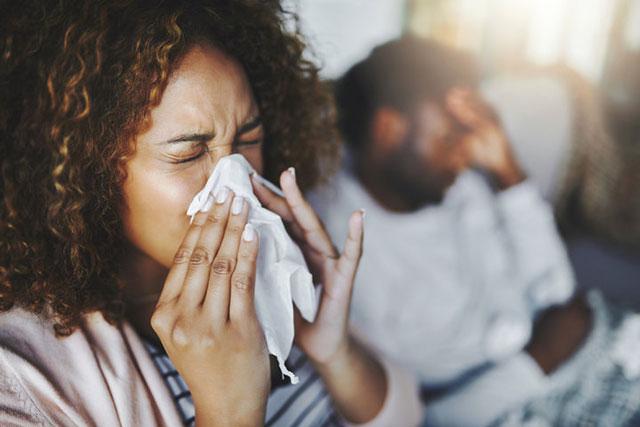You are here
Allergies: How to stay safe at school
By Zeina Sahyoun , Family Flavours - Apr 03,2022 - Last updated at Apr 04,2022

Photos courtesy of Family Flavours magazine
By Zeina Sahyoun
Genetics and Biotechnology Expert
School can be a stressful time, especially for children with allergies. Risks of an allergic reaction at school can be greater than at home because it’s more difficult to control the school environment. To help reduce food allergy emergencies at school, start with these tips.
Triggers
Kids can face allergies at school, both indoors and out from:
• Foods like nuts, milk, eggs, wheat and soy, among others
• Classroom triggers like mould, dust mites and chalk dust
• Outside risk factors such as bee stings and plant or pollen allergies
Knowing your child’s allergies
If you suspect your child is suffering from a food allergy or even a seasonal allergy due to the weather or pollen in the air, it is advisable to get your child tested. If your child is exhibiting symptoms, ask your doctor about performing a simple blood test to check for circulating IgE levels and a RAST panel to test the body’s reaction to a list of food and inhalant allergens. Ask your paediatrician about skin testing if your child is not exhibiting symptoms but you suspect an allergy or would just like to know what your child might be allergic to. A skin test is more effective in this case because the body does not produce allergy-related antibodies (IgE) that can be detected through a blood test if no reaction is taking place.
Treating your child’s allergies
If your child suffers from common seasonal allergies, you’re not alone. Many children in Jordan suffer such allergies, which even results in children missing school. Symptoms like fatigue, headache, sneezing, runny noses, watery eyes and itchiness can get in the way of attention and concentration, so it’s worth asking your paediatrician about appropriate antihistamine or nasal spray medications to see your child through the allergy season.
Knowing the school’s procedures on allergies
Your first step is to inform the school of any food allergies your child may have. Ask if any paperwork needs to be filled out and signed before school starts, and find out if the school has a full-time doctor or nurse on-site at all times. Ask how allergic reactions would be handled, including how you’d be notified. Meet the nurse or doctor and let them know who you and your child are. Discuss your child’s allergies in detail so they remember your child.
Having an Allergy Action Plan
When a child is having an allergic reaction, every second counts. An allergy action plan helps ensure that teachers, the school nurse and administrators immediately know what to do if your child has an allergic reaction. Ensure any emergency medications are readily available if your child begins to show symptoms such as swelling, wheezing, or difficulty breathing. Your child’s allergy action plan should cover all settings where the child spends significant time during the school day.
Providing medications
If your child requires allergy medication (antihistamine, inhaler or epinephrine autoinjector), find out where the medication will be stored at school. For example, is it kept in the nurse’s office, or can your child keep it with them in the classroom or in a locker? Then, when you send medication to school, make sure it’s properly labelled, hasn’t expired and that your child and the school nurse know how and when to use it.
Talking to teachers
Teachers play an important role in keeping children with allergies safe at school. Teachers must be aware of the child’s allergies, know the triggers the child needs to avoid while at school and be familiar with the signs of an allergic reaction. Teachers should also be trained on how to handle an allergy emergency because allergic reactions can progress rapidly.
Educating your child
Children with allergies should learn what they’re allergic to and understand the fact that they can have an allergic reaction if exposed to these triggers. Kids with food allergies should know what foods are unsafe for them and should never share food with friends or eat anything if they’re unsure what’s in it. It is best to pack a lunch from home for young children with allergies.
Children who might have an allergic reaction to bee stings should know the importance of wearing long trousers and long-sleeved clothing when outside.
Even if your child does not have any allergies, educate your child on why the school does not allow food that contains nuts on campus and about the importance of not sharing food, particularly with children known to have food allergies. If your child is friends with a child with allergies, it would be wise to educate him on how to recognise basic signs of allergic reactions and inform a teacher immediately.
Having your child wear a medic alert bracelet
Students at risk of a severe allergic reaction should wear a medic alert bracelet along with their new back-to-school clothes — some companies make fashion-forward styles that can be fun to wear. A medic alert bracelet can help inform others of the child’s allergies so that responders can make informed decisions about how to care for him or her during an emergency.
Making sure everyone is on the same page
For children with allergies, all potential caregivers must be informed of how to act in an emergency. This doesn’t end at the door of the school. Bus drivers, after-school programme employees, athletic coaches and babysitters all need to understand allergy triggers, symptoms of an allergic reaction and the proper protocol to follow to keep your child safe.
Educating yourself
While children with allergies are busy learning, mama and baba should take the opportunity to follow suit. Read Family Flavours and visit the website of the American Academy of Allergy, Asthma & Immunology, and the American Academy of Paediatrics for more information on managing allergies in children, at school and at home.
Reprinted with permission from Family Flavours magazine
Related Articles
AMMAN — “I cannot enjoy spring or flowers or even playing with cute cats because of my allergies.
AMMAN — The Jordanian Society for Allergy and Immunology of the Jordan Medical Association (JMA) has called for the establishment of a natio
Based on two dozen clinical trials, US researchers find that expensive mattress covers make no difference in reducing dust mite allergies or their symptoms.













